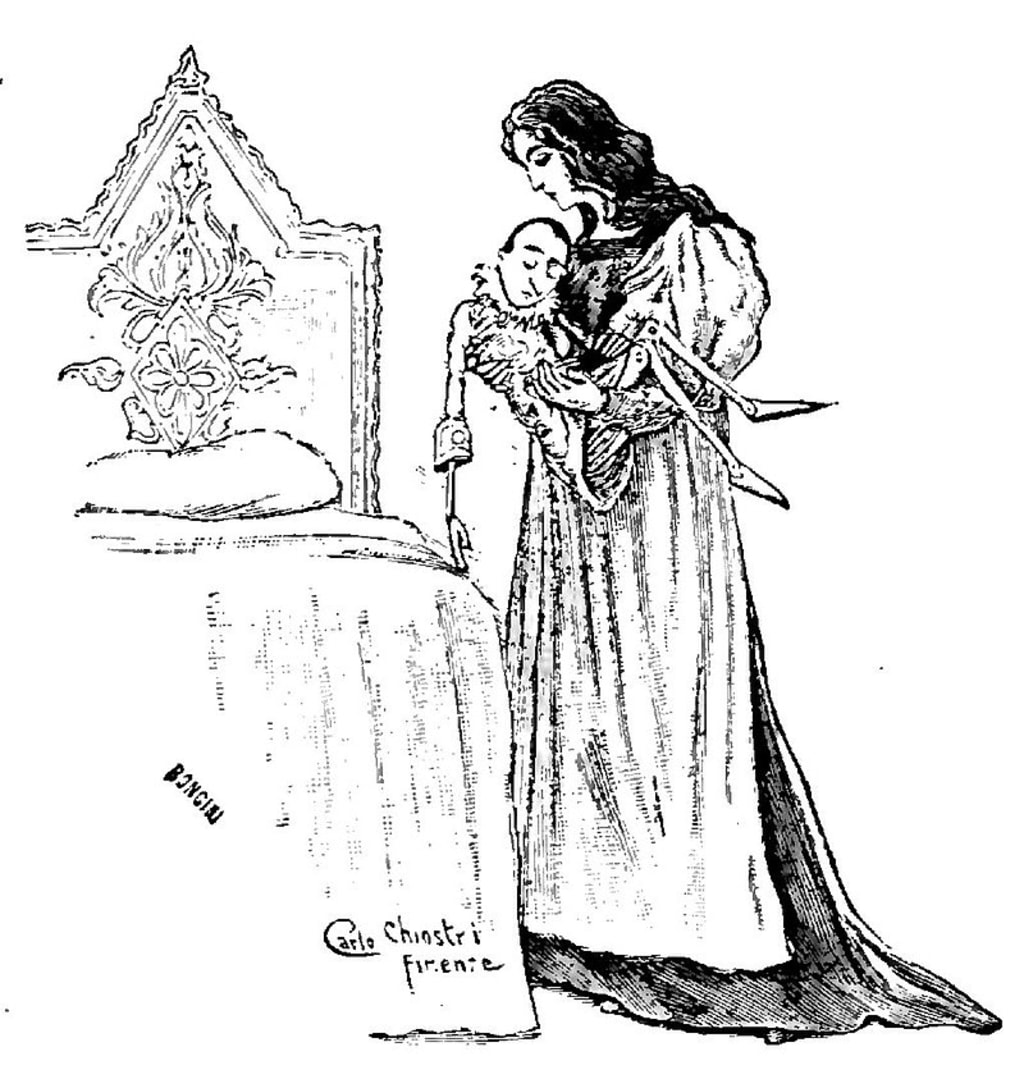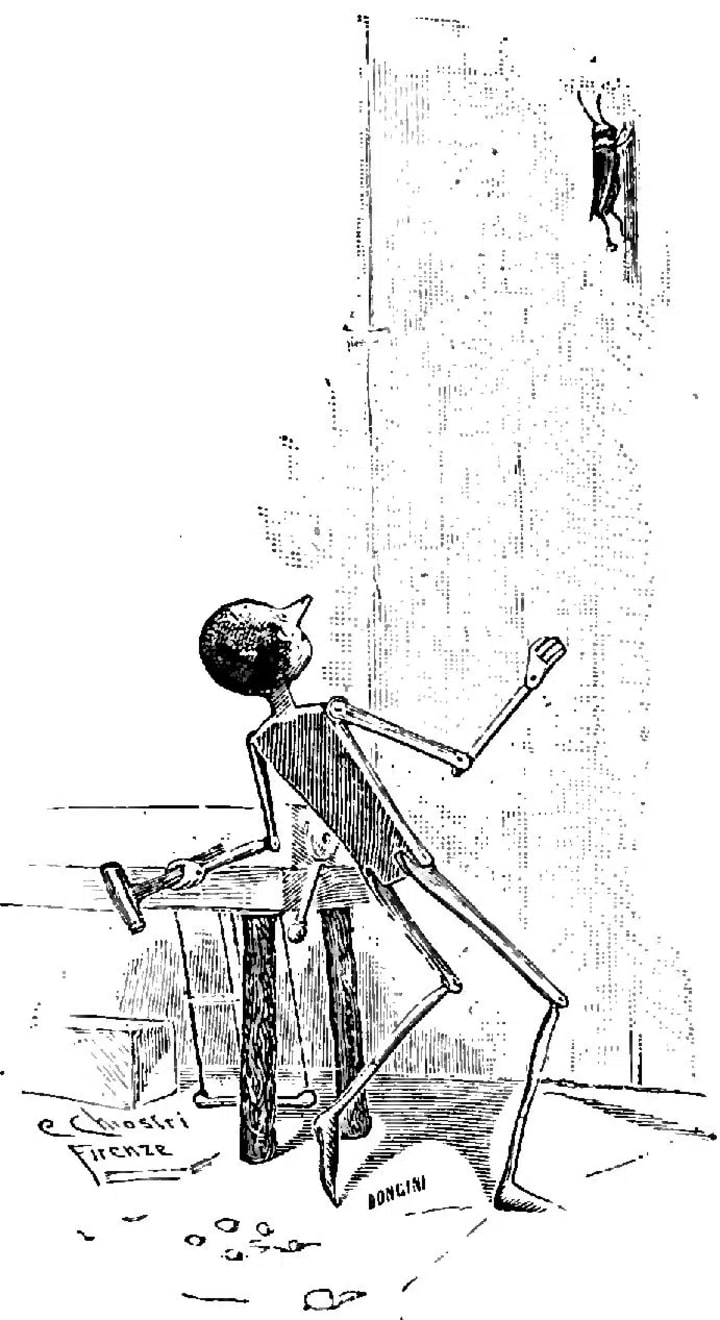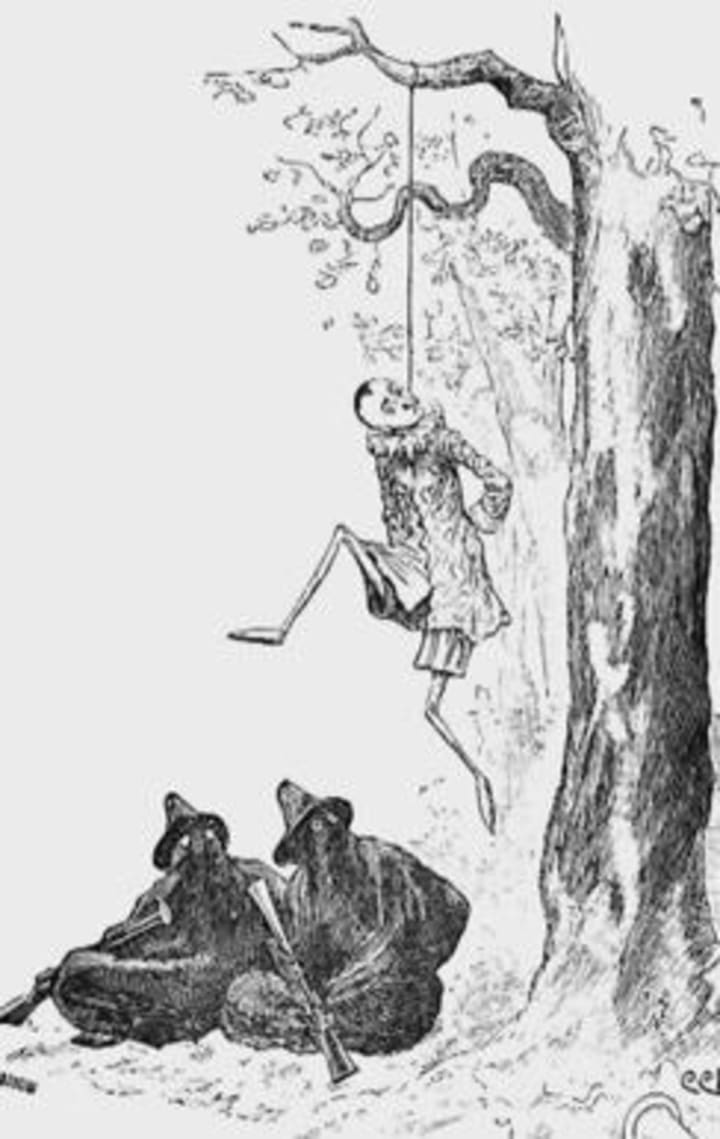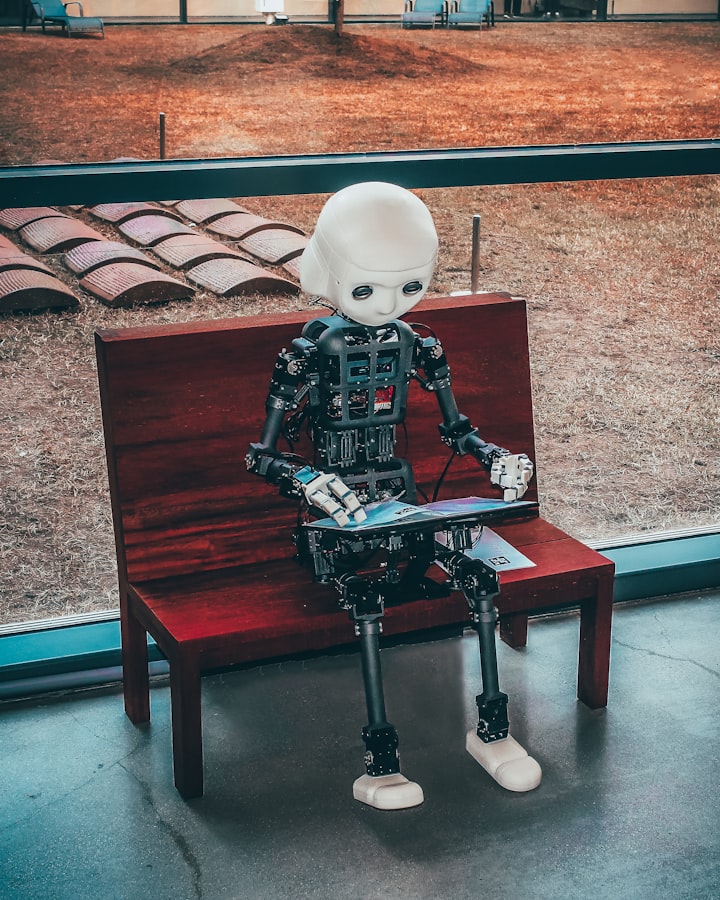Dark Origins – The shockingly dark original story of Pinocchio
Book analysis and discussion

Introduction
The Adventures of Pinocchio is a children’s fantasy novel by Italian author, Carlo Collodi.
The story was originally published as a serial called The Story of a Puppet in the Giornale per I bambini, one of the earliest Italian weekly magazines for children starting from 7 July 1881. Originally, the story stopped after 8 episodes (published over 4 months) at Chapter 15. Due to popular demand, the episodes were resumed on 16 February 1882 and the following year, the story was published as a single book.
The storyline
In Tuscany, Italy, a carpenter named Master Antonio finds a block of wood which he immediately plans to carve into a table let. The log cries out when he cuts it. Master Antonio falls to the floor as a result of shock and just at that moment his extremely poor neighbour, Geppetto, knocks on the door. The piece of wood instigates an altercation between the pair, but after a minor fisticuff, Geppetto receives the log as a gift. Geppetto is delighted and carves it into a marionette with the plan of making a living as a travelling puppeteer.
Quote: “On hearing himself called Polendina for the third time, Geppetto lost his head with rage and threw himself upon the carpenter. Then and there they gave each other a sound thrashing.
After this fight, Mastro Antonio had two more scratches on his nose, and Geppetto had two buttons missing from his coat. Thus having settled their accounts, they shook hands and swore to be good friends for the rest of their lives.
Then Geppetto took the fine piece of wood, thanked Mastro Antonio, and limped away toward home.”
As soon as Geppetto sets about carving the wood it becomes obvious that the puppet, called Pinocchio, will not be of good character.
Quote: “As he was about to put the last touches on the finger tips, Geppetto felt his wig being pulled off. He glanced up and what did he see? His yellow wig was in the Marionette’s hand. “Pinocchio, give me my wig!”
But instead of giving it back, Pinocchio put it on his own head, which was half swallowed up in it.
At that unexpected trick, Geppetto became very sad and downcast, more so than he had ever been before.
“Pinocchio, you wicked boy!” he cried out. “You are not yet finished, and you start out by being impudent to your poor old father. Very bad, my son, very bad!”
And he wiped away a tear.
The legs and feet still had to be made. As soon as they were done, Geppetto felt a sharp kick on the tip of his nose.
“I deserve it!” he said to himself. “I should have thought of this before I made him. Now it’s too late!””
Geppetto teaches Pinocchio to walk and he immediately runs away. The ungrateful puppet is caught by a law enforcement officer who, acting on the erroneous belief that Geppetto has mistreated the puppet, arrests Geppetto and puts him in prison.
Pinocchio returns to the empty house and meets the talking cricket which warms him of the perils of disobedience. In retaliation, Pinocchio throws a hammer at the cricket and accidentally kills it.

Picture caption: Pinocchio, a wooden puppet, throws a hammer at the cricket. https://www.historydefined.net/original-pinocchio/
Having tried unsuccessfully to obtain some food, the puppet settles down to sleep on a stove. When he wakes up, his feet have been burned off. Luckily for Pinocchio, Geppetto is released from prison and returns home. He makes Pinocchio new feet. Caught up in short lived gratitude, Pinocchio agrees to attend school and Geppetto sells his only coat to buy him a schoolbook.
Pinocchio never makes it to school on that first day and his disobedience gets him into significant trouble. He narrowly escapes being used as firewood to cook a hungry puppeteer’s dinner. A fisherman coats him in flour and tries to fry him. As punishment for refusing to study, he is transformed into a donkey and thrown into the sea.
The worse of all his violent adventures is when Pinocchio is lynched from a tree by his recurring enemies, the Fox and the Cat. This is the point when Collodi ended his original Pinocchio magazine series. It was only popular demand by his readers that resulted in the Collodi reviving his puppet hero and finding a way out of this scrape for him.

Picture credit: Pinocchio hanging by his neck while the two assassins’ watch on. https://www.cbsnews.com/news/the-birthplace-of-pinocchio/
Quote: “Happily for him, Pinocchio was made of very hard wood and the knives broke into a thousand pieces. The Assassins looked at each other in dismay, holding the handles of the knives in their hands.
“I understand,” said one of them to the other, “there is nothing left to do now but to hang him.”
“To hang him,” repeated the other.
They tied Pinocchio’s hands behind his shoulders and slipped the noose around his neck. Throwing the rope over the high limb of a giant oak tree, they pulled till the poor Marionette hung far up in space.
Satisfied with their work, they sat on the grass waiting for Pinocchio to give his last gasp. But after three hours the Marionette’s eyes were still open, his mouth still shut and his legs kicked harder than ever.
Tired of waiting, the Assassins called to him mockingly: “Good-by till tomorrow. When we return in the morning, we hope you’ll be polite enough to let us find you dead and gone and with your mouth wide open.” With these words they went.
A few minutes went by and then a wild wind started to blow. As it shrieked and moaned, the poor little sufferer was blown to and fro like the hammer of a bell. The rocking made him seasick and the noose, becoming tighter and tighter, choked him. Little by little a film covered his eyes.
Death was creeping nearer and nearer, and the Marionette still hoped for some good soul to come to his rescue, but no one appeared. As he was about to die, he thought of his poor old father, and hardly conscious of what he was saying, murmured to himself:
“Oh, Father, dear Father! If you were only here!”
These were his last words. He closed his eyes, opened his mouth, stretched out his legs, and hung there, as if he were dead.”
After this, Pinocchio’s story then continues its series of bleak set-pieces until finally our hero learns not to run away from his responsibilities. He begins to study hard and becomes a ‘good little kid’ and, at last, a real boy.
The dark origin of Pinocchio
It is clear from the narrative above the Pinocchio is a very dark story filled with violence, hunger, and illness. To understand how this story came about, the childhood of the author needs to be considered. According to https://metro.co.uk/, the house where Carlo Collodi was born in Florence in 1826, was on a long, narrow residential street which did not allow for any natural sunlight. He was the oldest of ten children and, to ease the burden on his parents, was sent away to live in a village with his mother’s family for much of his childhood.
While he was away, his family suffered a series of tragedies. Six of his nine siblings died before reaching adulthood. Some passed away as babies, while others lived long enough to become established parts of the family only to die later into childhood. The bleaker aspects of ‘The Adventures of Pinocchio’ are informed by the lasting impact of this pain on the author.
Themes
The themes of hunger, illness, and death are prevalent throughout the story.
Quotes:
“Are you not afraid of death?’
I am not in the least afraid!… I would rather die than drink that bitter medicine.’
At that moment the door of the room flew open, and four rabbits as black as ink entered carrying on their shoulders a little bier.
What do you want with me?’ cried Pinocchio, sitting up in bed in a great fright.
We are come to take you,’ said the biggest rabbit.
To take me?… But I am not yet dead!…’
No, not yet: but you have only a few minutes to live, as you have refused the medicine that would have cured you of the fever.’
Oh, Fairy, Fairy!’ the puppet then began to scream, ‘give me the tumbler at once… be quick, for pity’s sake, for I will not die–no… I will not die….”
***
“That puppet there,’ continued the Talking-cricket, ‘is a confirmed rogue. …’ Pinocchio opened his eyes, but shut them again immediately. ‘He is a ragamuffin, a do-nothing, a vagabond. …. Pinocchio hid his face beneath the clothes. ‘That puppet there is a disobedient son who will make his poor father die of a broken heart! …’ At that instant a suffocated sound of sobs and crying was heard in the room. Imagine everybody’s astonishment when, having raised the sheets a little, it was discovered that the sounds came from Pinocchio. ‘When the dead person cries, it is a sign that he is on the road to get well,’ said the Crow solemnly. ‘I grieve to contradict my illustrious friend and colleague,’ added the Owl, ‘but for me, when the dead person cries, it is a sign that he is sorry to die.”
***
“A boy’s appetite grows very fast, and in a few moments the queer, empty feeling had become hunger, and the hunger grew bigger and bigger, until soon he was as ravenous as a bear.
Poor Pinocchio ran to the fireplace where the pot was boiling and stretched out his hand to take the cover off, but to his amazement the pot was only painted! Think how he felt! His long nose became at least two inches longer.
He ran about the room, dug in all the boxes and drawers, and even looked under the bed in search of a piece of bread, hard though it might be, or a cookie, or perhaps a bit of fish. A bone left by a dog would have tasted good to him! But he found nothing.
And meanwhile his hunger grew and grew.”
Moral of the story
The moral of the story is that hard work, being good, and studying hard are the keys to success and it is only when Pinocchio devotes himself to the achievement of these three things that he transforms from a wooden puppet to a real boy with modern comforts. However, the author never lets the reader forget that disaster is always waiting to happen.
Quotes:
“I was just saying,” whined the Marionette in a whisper, “that it seems too late for me to go to school now.”
“No, indeed. Remember it is never too late to learn.”
“But I don’t want either trade or profession.”
“Why?”
“Because work wearies me!”
“My dear boy,” said the Fairy, “people who speak as you do usually end their days either in a prison or in a hospital. A man, remember, whether rich or poor, should do something in this world. No one can find happiness without work. Woe betide the lazy fellow! Laziness is a serious illness and one must cure it immediately; yes, even from early childhood. If not, it will kill you in the end.”
These words touched Pinocchio’s heart. He lifted his eyes to his Fairy and said seriously: “I’ll work; I’ll study; I’ll do all you tell me. After all, the life of a Marionette has grown very tiresome to me and I want to become a boy, no matter how hard it is. You promise that, do you not?”
“Yes, I promise, and now it is up to you.”
***
“Poor Pinocchio huddled close to the doghouse more dead than alive from cold, hunger, and fright. Now and again he pulled and tugged at the collar which nearly choked him and cried out in a weak voice:
“I deserve it! Yes, I deserve it! I have been nothing but a truant and a vagabond. I have never obeyed anyone and I have always done as I pleased. If I were only like so many others and had studied and worked and stayed with my poor old father, I should not find myself here now, in this field and in the darkness, taking the place of a farmer’s watchdog. Oh, if I could start all over again! But what is done can’t be undone, and I must be patient!””
If you would like to read the original The Adventures of Pinocchio, you can find it for free on Gutenberg here: https://www.gutenberg.org/files/500/500-h/500-h.htm
About the Creator
Robbie Cheadle
Robbie Cheadle loves to create in a variety of mediums including words, cake, fondant, charcoal, and oil pastels. She enjoys writing fantasy stories for children, poetry, and paranormal stories for adults in historical settings.






Comments
There are no comments for this story
Be the first to respond and start the conversation.